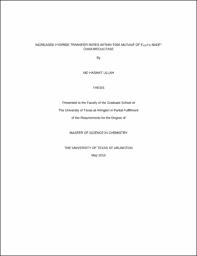
ATTENTION: The works hosted here are being migrated to a new repository that will consolidate resources, improve discoverability, and better show UTA's research impact on the global community. We will update authors as the migration progresses. Please see MavMatrix for more information.
Show simple item record
| dc.contributor.advisor | Johnson-Winters, Kayunta | |
| dc.creator | Ullah, Md Hasmat | |
| dc.date.accessioned | 2019-07-16T22:04:22Z | |
| dc.date.available | 2019-07-16T22:04:22Z | |
| dc.date.created | 2016-05 | |
| dc.date.issued | 2016-05-18 | |
| dc.date.submitted | May 2016 | |
| dc.identifier.uri | http://hdl.handle.net/10106/28362 | |
| dc.description.abstract | F420:H2 NADP+ oxidoreductase (Fno) is an F420 dependent enzyme found in methanogens and sulfate reducing archaea. Fno catalyzes the reversible reduction of NADP+ to NADPH through the transfer of a hydride involving F420 cofactor. The focus of our work is to study the hydride transfer mechanism of Fno from Archaeoglobus fulgidus using site directed mutagenesis, steady-state and pre steady-state kinetic methods. Threonine 09 (T09) is a conserved residue within Fno. The hydroxyl (–OH) group of T09 interacts with the phosphate and ribose of neighboring NADPH. Therefore, T09 was converted into an alanine (T09A) to study its functionality within Fno and its affects on the donor acceptor distances between FO and NADPH. Binding studies of T09A mutant revealed that T09 does not affect the binding of FO. However, this study revealed an increased dissociation constant for NADPH, which represents decreased affinity of Fno for NADPH. Like wildtype Fno (wtFno ), the steady-state kinetic studies of T09A Fno with varying concentrations of the deazaflavin chromophore of the F420 cofactor (FO) showed typical Michaelis-Menten hyperbolic plots. However, the steady-state kinetic studies varying NADPH concentrations displayed the biphasic non-hyperbolic properties. The kinetic parameter, kcat for FO is comparable with wtFno , however the Michaelis-Menten constant (Km) value was almost double than the wtFno . The Km for NADPH of the first phase was similar to wtFno. However, the data revealed a three fold increase in the Km for the second phase. According to the steady-state data, the presence of NADPH is required prior to FO for optimal activity for the T09A variant. The pre steady-state kinetic data revealed a 36-fold increased rate of hydride transfer for the T09A variant compared to wtFno. In contrast to wtFno pre steady-state kinetic data, T09A displayed a single-phase exponential decay, rather than biphasic burst kinetics. These data suggest that Threonine 09 plays a role in NADPH binding, the rate at which the hydride is transferred to the FO cofactor and subunit communication within the Fno dimer. | |
| dc.format.mimetype | application/pdf | |
| dc.subject | F420 cofactor | |
| dc.subject | F420 dependent NADP+ oxidoreductase | |
| dc.subject | Fno | |
| dc.subject | Hydride transfer | |
| dc.subject | Subunit communication | |
| dc.title | INCREASED HYDRIDE TRANSFER RATES WITHIN T09A MUTANT OF F420:H2 NADP+ OXIDOREDUCTASE | |
| dc.type | Thesis | |
| dc.degree.department | Chemistry and Biochemistry | |
| dc.degree.name | Master of Science in Chemistry | |
| dc.date.updated | 2019-07-16T22:04:23Z | |
| thesis.degree.department | Chemistry and Biochemistry | |
| thesis.degree.grantor | The University of Texas at Arlington | |
| thesis.degree.level | Masters | |
| thesis.degree.name | Master of Science in Chemistry | |
| dc.type.material | text | |
| dc.creator.orcid | 0000-0003-2839-4091 | |
Files in this item
- Name:
- ULLAH-THESIS-2016.pdf
- Size:
- 1.845Mb
- Format:
- PDF
This item appears in the following Collection(s)
Show simple item record


